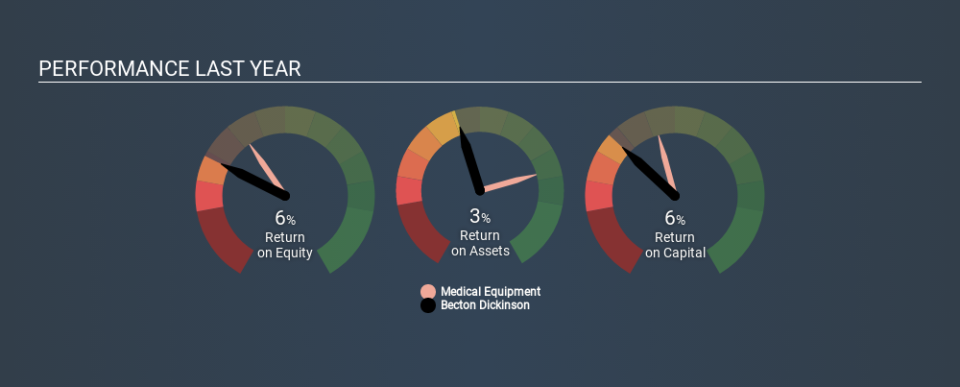Becton, Dickinson and Company’s (NYSE:BDX) Investment Returns Are Lagging Its Industry

Today we'll evaluate Becton, Dickinson and Company (NYSE:BDX) to determine whether it could have potential as an investment idea. Specifically, we're going to calculate its Return On Capital Employed (ROCE), in the hopes of getting some insight into the business.
First of all, we'll work out how to calculate ROCE. Next, we'll compare it to others in its industry. Last but not least, we'll look at what impact its current liabilities have on its ROCE.
What is Return On Capital Employed (ROCE)?
ROCE measures the 'return' (pre-tax profit) a company generates from capital employed in its business. All else being equal, a better business will have a higher ROCE. Overall, it is a valuable metric that has its flaws. Author Edwin Whiting says to be careful when comparing the ROCE of different businesses, since 'No two businesses are exactly alike.
How Do You Calculate Return On Capital Employed?
The formula for calculating the return on capital employed is:
Return on Capital Employed = Earnings Before Interest and Tax (EBIT) ÷ (Total Assets - Current Liabilities)
Or for Becton Dickinson:
0.063 = US$2.9b ÷ (US$52b - US$5.7b) (Based on the trailing twelve months to September 2019.)
So, Becton Dickinson has an ROCE of 6.3%.
See our latest analysis for Becton Dickinson
Does Becton Dickinson Have A Good ROCE?
One way to assess ROCE is to compare similar companies. We can see Becton Dickinson's ROCE is meaningfully below the Medical Equipment industry average of 9.1%. This performance could be negative if sustained, as it suggests the business may underperform its industry. Aside from the industry comparison, Becton Dickinson's ROCE is mediocre in absolute terms, considering the risk of investing in stocks versus the safety of a bank account. It is possible that there are more rewarding investments out there.
We can see that, Becton Dickinson currently has an ROCE of 6.3%, less than the 10% it reported 3 years ago. So investors might consider if it has had issues recently. The image below shows how Becton Dickinson's ROCE compares to its industry, and you can click it to see more detail on its past growth.
When considering ROCE, bear in mind that it reflects the past and does not necessarily predict the future. Companies in cyclical industries can be difficult to understand using ROCE, as returns typically look high during boom times, and low during busts. This is because ROCE only looks at one year, instead of considering returns across a whole cycle. Future performance is what matters, and you can see analyst predictions in our free report on analyst forecasts for the company.
Becton Dickinson's Current Liabilities And Their Impact On Its ROCE
Liabilities, such as supplier bills and bank overdrafts, are referred to as current liabilities if they need to be paid within 12 months. Due to the way ROCE is calculated, a high level of current liabilities makes a company look as though it has less capital employed, and thus can (sometimes unfairly) boost the ROCE. To counter this, investors can check if a company has high current liabilities relative to total assets.
Becton Dickinson has total assets of US$52b and current liabilities of US$5.7b. Therefore its current liabilities are equivalent to approximately 11% of its total assets. It is good to see a restrained amount of current liabilities, as this limits the effect on ROCE.
The Bottom Line On Becton Dickinson's ROCE
With that in mind, we're not overly impressed with Becton Dickinson's ROCE, so it may not be the most appealing prospect. You might be able to find a better investment than Becton Dickinson. If you want a selection of possible winners, check out this free list of interesting companies that trade on a P/E below 20 (but have proven they can grow earnings).
I will like Becton Dickinson better if I see some big insider buys. While we wait, check out this free list of growing companies with considerable, recent, insider buying.
If you spot an error that warrants correction, please contact the editor at editorial-team@simplywallst.com. This article by Simply Wall St is general in nature. It does not constitute a recommendation to buy or sell any stock, and does not take account of your objectives, or your financial situation. Simply Wall St has no position in the stocks mentioned.
We aim to bring you long-term focused research analysis driven by fundamental data. Note that our analysis may not factor in the latest price-sensitive company announcements or qualitative material. Thank you for reading.

